ARVAL WOODY, CHAIR MAKER
ITEM LIST - FOLDER #10 - Photographs, taken by D.H.
Ramsey Library staff, December 2006. |
| Note: Photographs by Helen Wykle, for D.H. Ramsey Library, UNCA
Special Collections. |
| Box |
Folder |
Item |
Description |
Thumbnail |
| 1 |
10 |
woo10_001 |
Interior of the Chair Shop sales room with patron (Fern
Hayes) and shop assistant seated on Woody chairs. The open door to shop may
be seen in the background. |
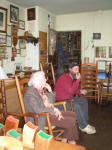 |
| |
|
woo10_002 |
View of the interior of the craft shop showing the tools and
storage shelves and locust floor of the shop. |
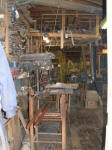 |
| |
|
woo10_003 |
View of the interior of the craft shop. |
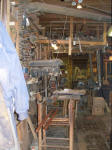 |
| |
|
woo10_004 |
View of the interior of Woody's Chair Shop in with the many
hand-made shop tools and storage innovations he used while creating his
chairs. |
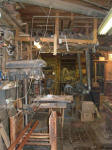 |
| |
|
woo10_005 |
Some of the other wood craft derived from the "waste" wood
in the shop and crafted by a variety of artisans who worked with and studied
with Arval Woody. Rarely did any wood become truly "waste" if it could be
used to fashion useful wood products. Maple, walnut, cherry, oak, and other
woods are used to create the many utilitarian objects |
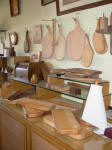 |
| |
|
woo10_006 |
View of the photographs and framed letters on the wall of the Chair
Shop. The framed photograph at center is Arthur Woody, Arval's grandfather, and the upper right
partial view of a photograph shows the presentation to John Kennedy of the two chairs for his
children by Governor Terry Sanford. |
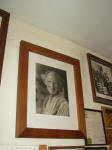 |
| |
|
woo10_007 |
View of the photographs and paintings on the wall of the Chair Shop.
Photograph is of Charles Woody, Arval's father. The painting, to the right,
is taken from
a photograph, and depicts the original Chair Shop with water-wheel, where the
first chairs in the family were made. |
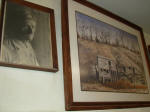 |
| |
|
woo10_008 |
Arval Woody selecting a chair back for notching. |
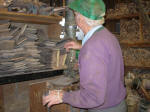 |
| |
|
w00009 |
Arval Woody feels his pocket for a pencil as he evaluates a chair back for creating
a notched pattern. |
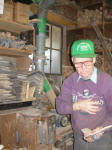 |
| |
|
woo10_010 |
Close view of Arval creating a notch in a chair back from a pattern. Injury to Arval's finger had occurred just days before this image was taken. In the
over 45 years he has been making chairs, injuries have been very few. |
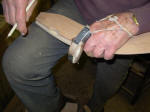 |
| |
|
woo10_011 |
Chair backs in preparation for shaping into the unique
notched pattern used by Arval Woody and his Shop for some of the Colonial
chairs. |
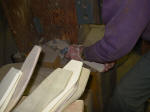 |
| |
|
woo10_012 |
Shop tool that has been modified to create the first shaping
of the chair legs. Note the 1800's date on the Levi Houston mortising machine. |
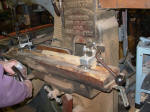 |
| |
|
woo10_013 |
Arval Woody demonstrating shop tools used in his craft. |
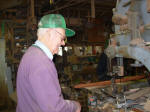 |
| |
|
woo10_014 |
Arval Woody demonstrating the polishing of a chair round in
an adapted lathe-finishing machine. |
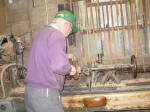 |
| |
|
woo10_015 |
View of the shop floor which utilizes square blocks of
locust sunk into earth as flooring. Originally the floor was dirt which
quickly became difficult as dust was a constant problem and sawdust could
not be cleared easily. The square posts of locust wood were sunk into the
shop floor and over the years the surface of the wood has taken on a smooth
finish as feet and sawdust have worn down the surface of the floor to a high
finish. |
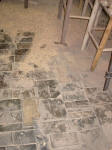 |
| |
|
woo10_016 |
Arval Woody demonstrating the use of his unique lathe used to form the
chair rounds and uprights. |
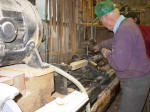 |
| |
|
woo10_017 |
Arval Woody in his shop with assistant demonstrating the use
of the lathe to produce chair rounds. |
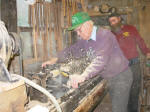 |
| |
|
woo10_018 |
Chair backs in a hand-made press that helps to retain uniformity
of curvature in the backs after they have been dried in the press molds.
Chair rounds are stacked in chair behind press. |
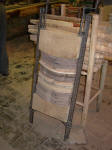 |
| |
|
woo10_019 |
View of the wood-storage area with chair-backs in press molds.
The backs are placed in the press molds to dry after they are taken from a
soak in a hot water bath. The hot water bath makes the wood pliant and
allows the gentle curve of the chair backs. |
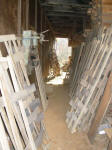 |
| |
|
woo10_020 |
A broad view of the interior of the work shop showing the exhaust
and venting system close to ceiling and work areas and tools, below. |
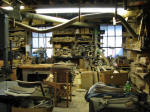 |
| |
|
woo10_021 |
Interior view of shop with raking view of storage areas to
the right of shop entry door. |
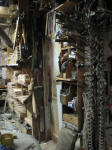 |
| |
|
woo10_022 |
Interior view of shop tools, showing lathe used to create
the chair rounds. |
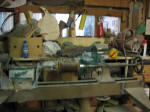 |
| |
|
woo10_023 |
Interior view of the shop showing drill used to create the
holes for the joins
for the chair-leg rungs. |
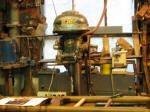 |
| |
|
woo10_024 |
A Levi Houston machine used by the Woodys to create
mortises for the chair backs. The tight tenon and mortise fit of all the
chair parts is an important hall-mark of all Woody's chairs. The machine is
dated Jan. 28, 1873 and Oct 17, 1882. The wood-working equipment seen
here, was invented by Levi
Houston, who owned a foundry and machine shop in Montgomery, Pennsylvania at the close of the nineteenth
century. The company he founded, Houston,
Smith and Company was renamed the Levi Houston
Co. in 1877 or 1878. Levi Houston was dead by 1897 and following his death,
his company merged to form the American
Wood Working Machine Company. It is remarkable that this machine has been in operation for at
least 125 years or more. It was adapted for use in the Woody Chair Shop, but
just when it
came to the Spruce Pine shop, is not known.
To read more about the company that made the machine:
http://www.owwm.com/MfgIndex/detail.asp?ID=454 |
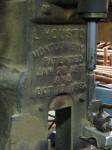 |
| |
|
woo10_025 |
Interior view of shop tool, the Levi Houston mortise machine,
which "punches" mortise slots i the chair uprights for the insertion of the "tenoned"
chair-backs. |
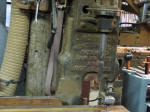 |
| |
|
woo10_026 |
Interior of shop. Close view of storage bins holding dowels
and chair-backs. |
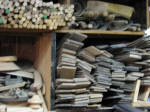 |
| |
|
woo10_027 |
Interior of shop with table saw in the foreground and other tools used in
crafting chairs, visible in the background. |
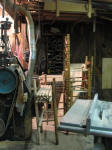 |
| |
|
woo10_028 |
View across finishing belt sander to back room used for
finishing chairs. |
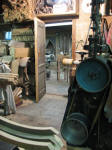 |
| |
|
woo10_029 |
Finishing tools against wall of the interior of the shop. |
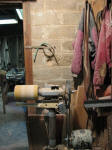 |
| |
|
woo10_030 |
Chairs used to hold turned rounds for chair uprights and
rungs. |
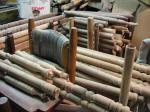 |
| |
|
woo10_031 |
Interior of workshop with chair legs in process and lathe
and polishing equipment under window. Lathe used to polish and sand rounds. |
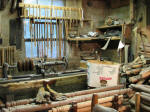 |
| |
|
woo10_032 |
Interior of workshop with chair legs in process and lathe
and polishing equipment under the window. Chairs holding uprights and rungs in
the
foreground. |
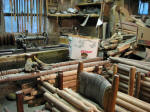 |
| |
|
woo10_033 |
Interior of workshop with chair uprights in process and lathe
and polishing equipment under window. |
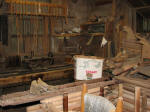 |
| |
|
woo10_034 |
View of interior of workshop across top of wood stove toward
entry door. |
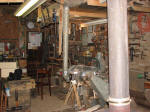 |
| |
|
woo10_035 |
Close view of locust squares floor with wood stove in
background. Chair uprights and rungs on chair next to stove. |
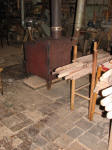 |
| |
|
woo10_036 |
View of the locust post floor in the shop with wood stove in
center of room. |
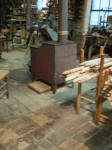 |
| |
|
woo10_037 |
View up into the ceiling of the shop area showing storage of
wood items. Every corner of the small shop area room has been utilized. |
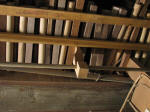 |
| |
|
woo10_038 |
View of finishing sanding belt, with empty press in
foreground and with finished chair in background. The large tube is used to
carry dust and fumes out of the shop. |
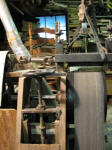 |
| |
|
woo10_039 |
Arval Woody's sister, Eleanora Woody Young, came for a visit with her husband
during UNCA's visit to the workshop. She agreed to sit for a portrait. She,
like other members of the family, helped in the chair manufacturing
business. |
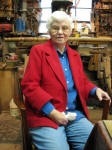 |
| |
|
woo10_040 |
A short drive was made to Arval Woody's home to see this unique
cherry coffee table that has the image of a fox or wolf in the grain and to
see many of the other wooden items given or traded with other craftsmen. The
trip only served to emphasize his extraordinary love of wood and the large
network of craftsmen that Arval knew through his work.. |
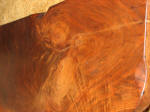 |
| |
|
woo10_041 |
View of "Fox" table of cherry. |
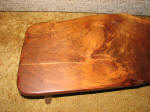 |
| |
|
woo10_042 |
About one mile from the shop is the home of Arval Woody and
throughout the home can be seen many of his crafts, and many of the awards
and honors given to he and his wife, Nora, over their life time. This award
of gratitude was given to Arval by the Grassy Creek Fire and Rescue, "In appreciation for the devoted years you have
spent with us. With this award of gratitude, goes our best wishes and
heartiest thanks. Grassy Creek Fire & Rescue. Feb. 22, 1982. Arval's
civic engagement is another instance of his pride of place. |
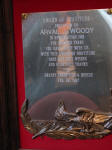 |
| |
|
woo10_043 |
Spruce Pine, in Mitchell County, NC, where the Woody's
Chair Shop is located, is dominated by mica and feldspar mining. High on the
mountain approaching Spruce Pine, one of the mining operations may be seen. |
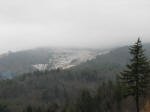 |
| |
|
woo10_044 |
Mitchell County is largely rural and the beauty of the
region and its rich cultural heritage of craft was one reason the early
craft school, Penland School of Crafts was established there by Miss Lucy
Morgan in 1923. The school has a national reputation for crafts and starting
in 1929 it has supported a residence program for artists. |
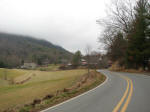 |
| |
|
woo10_045 |
Today the Penland School of Crafts occupies about 400 acres high on the
mountain in rustic buildings, some remaining from the early years when an
Episcopal school flourished on the site. The Woody family has long had a
connection with the school and Arthur, the grandfather of Arval Woody, was
invited there in the early years to provided instruction on chair making. These early chairs
by Arthur were typically mountain hickory-cane bottom
chairs, unlike the refined Colonial chairs produced by the later Woody's Chair
Shop. The practice of using no nails and the close joins for the uprights
and chair backs, is however found in both the early chairs and in the later
chairs. |
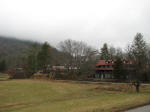 |
| |
|
woo10_046 |
Distant views of fog shrouded mountains, open fields, and
peaceful quite abound in this mountain-top setting, in contrast to the now,
rapidly developing strip-malls that today surround Woody's Chair Shop. While
the location of Woody's shop on busy Highway 19, provided access to easy
transport and drop-in by tourists, it slowly lost its rural associations as the geography and
the demographic evolved. |
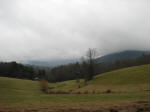 |
| |
|
|
|
|